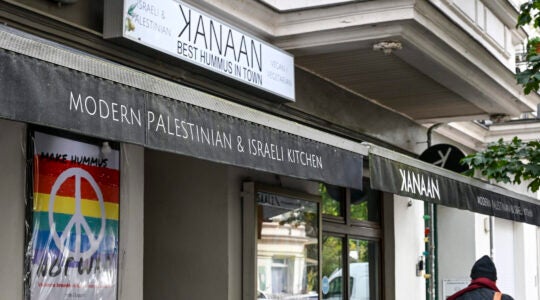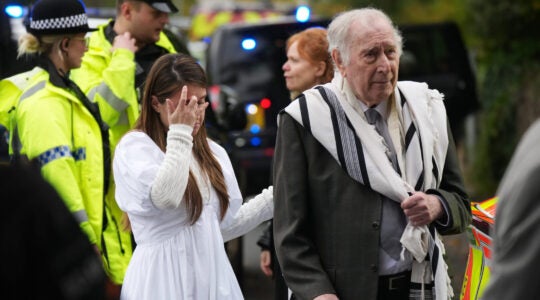BUDAPEST, Hungary (JTA) – For the first time in his 33 years, Peter says, a homegrown Hungarian movement is articulating a vision for how Hungarians can preserve their culture and traditions.
It doesn’t matter that members of the new Hungarian Guard parade in black combat boots and uniforms emblazoned with a red-and-white symbol reminiscent of the local Nazi party, which killed thousands of Jews during the Holocaust. Or that the Guard’s rallying cry to protect Hungarians against the “criminality” of Roma – Gypsies – stirs fear of interethnic clashes.
“I don’t want to talk about the Jews or Gypsies, because that’s what the media says the target is, and the media’s a joke,” says Peter, who withheld his last name. Dressed in black with slicked-back hair, Peter endured frigid weather to visit a Guard recruitment event on Sunday. “The real target is a better Hungary,” he says.
That is no comfort to the thousands of Holocaust survivors who still live in Budapest or to Hungary’s 100,000 or so Jews, the largest Jewish community in Central Europe.
It’s not so much the possibility of violence from the Hungarian Guard that troubles Jews here – the Guard, which has 1,000 or so members, is unarmed – but the apparent receptiveness of a growing number of Hungarians to far-right ideas.
Jewish, Roma and human rights groups already are pressing the government to ban the Guard, and some Roma are talking about forming self-defense militias.
The Hungarian Guard was created in August 2007 by a relatively new far-right political party, Jobbik, seeking votes and credibility on the right wing, experts say.
Showing increasingly sophistication over the last decade, the right wing has successfully infused mainstream public discourse with distinctions between “Hungarians” and “non-Hungarians” – with Jews and Roma on the outside.
This has revived the historic insider-outsider question for Hungarian Jews who saw themselves as assimilated members of Hungarian society, not as outsiders looking in.
“Even young people who are not racist or anti-Semitic use the same terminology, that you can’t be both Hungarian and a Jew,” says Andrea Szonyi, who co-founded the Holocaust education group Zachor: Foundation for Social Remembrance. “It leads us back to the Holocaust, when people who defined themselves as Hungarian were taken to the gas chambers as Jews.”
The rise of a far-right movement is not unique to Hungary.
Across Central and Eastern Europe, the revolutions of 1989-1990 that launched post-Communist transitions to democracy also enabled extremist groups to gain a foothold.
In Hungary, they more or less remained on the fringe until 1998, when Viktor Orban, once a blue-jeans-and-earring-wearing young member of the anti-Communist resistance, became prime minister and swung his party to the right, espousing nationalist, Christian values.
His party, Fidesz, formed a de facto coalition with the small ultra-nationalist Hungarian Justice and Life Party, whose playwright leader, Istvan Csurka, indulged in Jewish conspiracy theories.
Though he was never accused of anti-Semitism, Orban was criticized for not denouncing fellow Fidesz members who sometimes appealed to supporters with coded phrases viewed as anti-Semitic – for example, attacking rivals as “cosmopolitans,” “Communist Jews” or for possessing “foreign hearts.”
Many Hungarians rejected such rhetoric, but the genie was out of the bottle.
Zsidozas – a uniquely Hungarian term for “talking about Jews” – became more common in the media and in Parliament, and politics generally grew more toxic.
In September 2006, when Socialist Prime Minister Ferenc Gyurcsany was caught on tape admitting that he lied to voters “morning, evening and night” about the nation’s economic health to win re-election earlier that year, Orban and Fidesz, now leading the opposition, branded the Gyurcsany government illegitimate.
Daily demonstrations ensued. A new version of the Arpad flag – the red-and-white stripes from an ancient royal coat-of-arms also adopted by Hungary’s Nazi puppet regime in the Arrow Cross – began to appear at the demonstrations.
The new flag may have lacked the black Arrow Cross symbol that, like the Nazi swastika and Soviet hammer-and-sickle, is illegal to display in Hungary, but Hungarian liberals said nobody was fooled by what the new flag meant.
That flag has become a fixture at anti-government demonstrations, especially events put on by the Guard.
For some Jews here, the growth of the far-right movement, has been startling.
“Thank goodness my mother has Alzheimer’s,” says Katalin, whose mother survived the Budapest ghetto at age 17. “If she were OK, she would be very afraid, remembering the dark days of the Holocaust.” Katalin asked not to be identified by her last name.
Some Jews here say such fears may be overreactions, but the Guard’s affiliation with a legally registered political party, Jobbik, is cause for concern, says the president of the Federation of Hungarian Jewish Communities, Peter Feldmajer.
Jobbik polls at about 1 percent support, but the party shares seats with Fidesz on several local councils across the country.
“The Guard may be 1,000 or 2,000 crazy people who like to play soldier games, but on the other hand this party has a relationship with normal political life,” Feldmajer says.
Perhaps for this reason, the Guard has been cautious about avoiding public talk of Jews in citing their litany of historic injustices against Hungary. Instead, the Guard focuses on a more populist target: the Roma, who are widely disliked here.
Fueling public hatred, fear and negative stereotyping of the Roma, who are mired in poverty and unemployment that prompts some to turn to petty crime, the Guard portrays them all as “Gypsy criminals.” The Guard has been organizing weekly marches as shows of force in towns around the country with significant Roma populations.
Hungary’s population of about 10 million includes some 500,000 Roma.
The Guard “recognizes they can’t play the anti-Semitic card, because it will delegitimize them in a greater way than playing the anti-Roma card would,” says Michael Miller, an American professor of Jewish history in the nationalism studies program at Central European University in Budapest.
However, Miller notes, crowds at Guard demonstrations often will yell things like “Down with the Jews” or refer to Gyurcsany as a “Jewish hireling.”
Feldmajer says Jewish leaders are lobbying local mayors to ban the Guard from their cities. He told JTA he expects the state prosecutor’s office to decide soon if the Guard has violated its registration as a cultural and educational organization.
Meanwhile, observers say, it’s essential that mainstream Hungarian conservatives, led by Fidesz, publicly distance themselves from the right-wing extremists.
Several Fidesz officials already have done so, but Orban has not.
Andras Kadar, co-chairman of the Hungarian Helsinki Committee, a human rights group, says a hate-speech law Hungary passed on Monday – and which still may be challenged in court as violating free-speech rights – is key.
“This is an apt moment for state organs to deal with the issue of freedom of expression, freedom of association, and make clear that ‘democracy’ cannot serve to justify all sorts of racist acts,” Kadar says.
After Sunday’s Guard event, Peter, the potential recruit, said he wondered whether visible support for the Guard – such as driving members to marches – might hurt him professionally.
“I work for a big company,” he said. “Maybe they wouldn’t like that I’m a member, and it would cause some problems for me.”
JTA has documented Jewish history in real-time for over a century. Keep our journalism strong by joining us in supporting independent, award-winning reporting.





